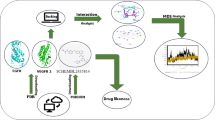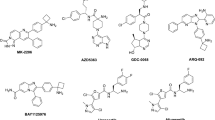Abstract
GPCRs remain the most important drug target comprising ~ 34% of the Food and Drug Administration (FDA)-approved drugs. In modern pharmacology of GPCRs, modulating receptor signaling based on requirement of a specific disorder is of immense interest. Classical drugs targeting orthosteric sites in GPCRs completely block the binding of endogenous ligand and consequently inhibit all important signals from a GPCR. Some of many signals elicited by the endogenous ligands may play vital role and inhibiting these may also cause severe side effects in the long run. However, allosteric drugs can modulate GPCR signaling without blocking the endogenous ligand binding. Therefore, allosteric drugs can maintain beneficial signaling of the receptor and prevent unwanted side effects. In this chapter, we will discuss GPCR crystal structures solved with allosteric ligands, advantages of allosteric drugs, and allosteric drugs which are in clinical use or trials.
Graphic Abstract



Similar content being viewed by others
References
Abdel-Magid F (2015) Allosteric modulators: an emerging concept in drug discovery. ACS Med Chem Lett 6:104–107
Acharya A, Coop JE, Polli AD, Mackerell Jr (2011) Recent advances in ligand-based drug design: relevance and utility of the conformationally sampled pharmacophore approach. Curr Comput Aided Drug Des 7:10–22
Balakrishnan A, Polli JE (2006) Apical sodium dependent bile acid transporter (ASBT, SLC10A2): a potential prodrug target. Mol Pharm 3:223–230
Butkiewicz M et al (2019) Identification of novel allosteric modulators of metabotropic glutamate receptor subtype 5 acting at site distinct from 2-methyl-6-(phenylethynyl)-pyridine binding. ACS Chem Neurosci 10:3427–3436
Cabral-Marques O et al (2018) GPCR-specific autoantibody signatures are associated with physiological and pathological immune homeostasis. Nat Commun 9:5224
Christopher JA et al (2015) Fragment and structure-based drug discovery for a class C GPCR: discovery of the mGlu5 negative allosteric modulator HTL14242 (3-Chloro-5-[6-(5-fluoropyridin-2-yl)pyrimidin-4-yl]benzonitrile). J Med Chem 58:6653–6666
Christopoulos A et al (2014) International Union of basic and clinical pharmacology. XC. Multisite pharmacology: recommendations for the nomenclature of receptor allosterism and allosteric ligands. Pharmacol Rev 66:918–947
Davenport P et al (2013) International Union of basic and clinical pharmacology. LXXXVIII. G protein-coupled receptor list: recommendations for new pairings with cognate ligands. Pharmacol Rev 65:967–986
de Graaf C, Rein C, Piwnica D, Giordanetto F, Rognan D (2011) Structure-based discovery of allosteric modulators of two related class B G-protein-coupled receptors. ChemMedChem 6:2159–2169
Deshpande I et al (2019) Smoothened stimulation by membrane sterols drives Hedgehog pathway activity. Nature 571:284–288
Dore S et al (2014) Structure of class C GPCR metabotropic glutamate receptor 5 transmembrane domain. Nature 511:557–562
Gacasan SB, Baker DL, Parrill AL (2017) G protein-coupled receptors: the evolution of structural insight. AIMS Biophys 4:491–527
Grover K (2013) Use of allosteric targets in the discovery of safer drugs. Med Princ Pract 22:418–426
Hauser S, Attwood MM, Rask-Andersen M, Schioth HB, Gloriam DE (2017) Trends in GPCR drug discovery: new agents, targets and indications. Nat Rev Drug Discov 16:829–842
Hauser S et al (2018) Pharmacogenomics of GPCR drug targets. Cell 172:41-54e19
Hu GM, Mai TL, Chen CM (2017) Visualizing the GPCR network: classification and evolution. Sci Rep 7:15495
Huang Z et al (2011) ASD: a comprehensive database of allosteric proteins and modulators. Nucleic Acids Res 39:D663-669
Huang Z et al (2014) ASD v2.0: updated content and novel features focusing on allosteric regulation. Nucleic Acids Res 42:D510-516
Kenakin T, Strachan RT (2018) PAM-antagonists: a better way to block pathological receptor signaling? Trends Pharmacol Sci 39:748–765
Koehl A et al (2019) Structural insights into the activation of metabotropic glutamate receptors. Nature 566:79–84
Kooistra AJ et al (2021) GPCRdb in 2021: integrating GPCR sequence, structure and function. Nucleic Acids Res 49(D1):D335–D343. https://doi.org/10.1093/nar/gkaa1080
Korczynska M et al (2018) Structure-based discovery of selective positive allosteric modulators of antagonists for the M2 muscarinic acetylcholine receptor. Proc Natl Acad Sci USA 115:E2419–E2428
Krishnan A, Nijmeijer S, de Graaf C, Schioth HB (2016) Classification, nomenclature, and structural aspects of adhesion GPCRs. Handb Exp Pharmacol 234:15–41
Kruse C et al (2013) Activation and allosteric modulation of a muscarinic acetylcholine receptor. Nature 504:101–106
Kurogi Y, Guner OF (2001) Pharmacophore modeling and three-dimensional database searching for drug design using catalyst. Curr Med Chem 8:1035–1055
Lamim Ribeiro JM, Filizola M (2019) Allostery in G protein-coupled receptors investigated by molecular dynamics simulations. Curr Opin Struct Biol 55:121–128
Liang YL et al (2020) Structure and dynamics of adrenomedullin receptors AM1 and AM2 reveal key mechanisms in the control of receptor phenotype by receptor activity-modifying proteins. ACS Pharmacol Transl Sci 3:263–284
Liu X et al (2017) Mechanism of intracellular allosteric beta2AR antagonist revealed by X-ray crystal structure. Nature 548:480–484
Liu H et al (2018) Orthosteric and allosteric action of the C5a receptor antagonists. Nat Struct Mol Biol 25:472–481
Liu X et al (2020a) An allosteric modulator binds to a conformational hub in the beta2 adrenergic receptor. Nat Chem Biol 16:749–755
Liu X et al (2020b) Unraveling allosteric landscapes of allosterome with ASD. Nucleic Acids Res 48:D394–D401
Lu J et al (2017) Structural basis for the cooperative allosteric activation of the free fatty acid receptor GPR40. Nat Struct Mol Biol 24:570–577
Luckmann M et al (2019) Molecular dynamics-guided discovery of an ago-allosteric modulator for GPR40/FFAR1. Proc Natl Acad Sci USA 116:7123–7128
Maeda S, Qu Q, Robertson MJ, Skiniotis G, Kobilka BK (2019) Structures of the M1 and M2 muscarinic acetylcholine receptor/G-protein complexes. Science 364:552–557
Meyer C, Heidecke H (2018) Antibodies against GPCR. Front Biosci 23:2177–2194
Oldham WM, Hamm HE (2008) Heterotrimeric G protein activation by G-protein-coupled receptors. Nat Rev Mol Cell Biol 9:60–71
Schulze W, Kunze R, Wallukat G (2005) Pathophysiological role of autoantibodies against G-protein-coupled receptors in the cardiovascular system. Exp Clin Cardiol 10:170–172
Shao Z et al (2019) Structure of an allosteric modulator bound to the CB1 cannabinoid receptor. Nat Chem Biol 15:1199–1205
Shen Q et al (2016) ASD v3.0: unraveling allosteric regulation with structural mechanisms and biological networks. Nucleic Acids Res 44:D527-535
Sriram K, Insel PA (2018) G Protein-coupled receptors as targets for approved drugs: how many targets and how many drugs? Mol Pharmacol 93:251–258
Takakura Y, Hashida M (1995) Macromolecular drug carrier systems in cancer chemotherapy: macromolecular prodrugs. Crit Rev Oncol Hematol 18:207–231
Taylor M et al (2010) Using ligand-based virtual screening to allosterically stabilize the activated state of a GPCR. Chem Biol Drug Des 75:325–332
Tolle-Sander S, Lentz KA, Maeda DY, Coop A, Polli JE (2004) Increased acyclovir oral bioavailability via a bile acid conjugate. Mol Pharm 1:40–48
Vaidehi N, Bhattacharya S (2016) Allosteric communication pipelines in G-protein-coupled receptors. Curr Opin Pharmacol 30:76–83
Wakefield E, Mason JS, Vajda S, Keseru GM (2019) Analysis of tractable allosteric sites in G protein-coupled receptors. Sci Rep 9:6180
Wenthur J, Gentry PR, Mathews TP, Lindsley CW (2014) Drugs for allosteric sites on receptors. Annu Rev Pharmacol Toxicol 54:165–184
Wingler LM, McMahon C, Staus DP, Lefkowitz RJ, Kruse AC (2019) Distinctive activation mechanism for angiotensin receptor revealed by a synthetic nanobody. Cell 176:479-490e412
Wu H et al (2014) Structure of a class C GPCR metabotropic glutamate receptor 1 bound to an allosteric modulator. Science 344:58–64
Wu F et al (2020) Full-length human GLP-1 receptor structure without orthosteric ligands. Nat Commun 11:1272
Xia Y, Kellems RE (2011) Receptor-activating autoantibodies and disease: preeclampsia and beyond. Expert Rev Clin Immunol 7:659–674
Xu Y et al (2019) Mutagenesis facilitated crystallization of GLP-1R. IUCrJ 6:996–1006
Yu W, MacKerell AD Jr (2017) Computer-aided drug design methods. Methods Mol Biol 1520:85–106
Zheng Y et al (2016) Structure of CC chemokine receptor 2 with orthosteric and allosteric antagonists. Nature 540:458–461
Zhou Q et al (2019) Common activation mechanism of class A GPCRs. Elife 8:50279
Acknowledgements
This work was supported by National Institutes of Health Grants, HL132351 and R01HL142091, and LRI Chair’s Innovative Research Award to S.S.K. We thank Russell Desnoyer for his comments and suggestions on this chapter.
Author information
Authors and Affiliations
Corresponding author
Additional information
Publisher's Note
Springer Nature remains neutral with regard to jurisdictional claims in published maps and institutional affiliations.
Rights and permissions
About this article
Cite this article
Singh, K.D., Karnik, S.S. Current Trends in GPCR Allostery. J Membrane Biol 254, 293–300 (2021). https://doi.org/10.1007/s00232-020-00167-6
Received:
Accepted:
Published:
Issue Date:
DOI: https://doi.org/10.1007/s00232-020-00167-6




